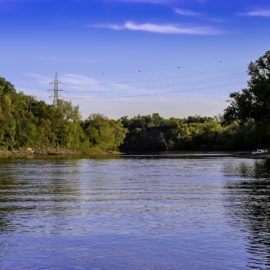
This is a story of a waterway with a west and east bank. One is thriving and one is not. One has water and silt running through it and the other does not. The one lacking the silt needs the Diversion which has two affected parishes against it. What is needed is both sides, both banks, looking the same with vibrant growth and an active habitat.
Chugging through Bay Denesse, Ryan Lambert’s boat struggles forward, kicking up the silt and clay sitting just a few feet below the water’s surface. The smell of wet earth permeates the air, wafting up from the brown, muddy water and verdant freshwater marsh. Some patches of grass are obviously new, their green tips emerging from the water. “There wasn’t a speck of anything except water three years ago,” Lambert said, gesturing from behind the wheel as his engine sputtered. Natural crevasses carved by the Mississippi River in the flood of 1973 — as well as man-made cuts added in 2006 — now carry heavy sediment to the marshes near historic Fort St. Philip along Plaquemines Parish’s east bank. That massive flood significantly altered the landscape, scouring out marsh that was already rapidly degrading with the rest of Louisiana’s coast due to subsidence, erosion, oil and gas exploration and hurricanes.
nola.com
The Federal Study showed that for the first 25 years degradation occurred but by 2019 over 1000 acres of land had been built from 2008 through 2017. On the other side the degradation still continues. Enter the Mid-Barataria Diversion which will harness the land building characteristics of the Mississippi.
“When you come out here, you know that the resource can become infinite,” said Chris Macaluso, a Baton Rouge-based recreational fishing advocate with the Theodore Roosevelt Conservation Partnership. “The river’s got infinite possibilities to come out here and build habitat and establish new lands.” Scientists hope the diversion will rebuild and nourish 27 square miles over 24 years by channeling up to 75,000 cubic feet per second of sediment-rich river water across two miles into Barataria Bay during the spring floods. Unlike its dredge-and-pump marsh creation projects, Louisiana Coastal Protection and Restoration Authority officials say that the diversion is the only project able to keep up with sea-level rise.
Opponents argue that the fishing industry would be killed as the fresh water would destroy the oyster beds and drive off or kill the dolphins. The brown shrimp would bwe heavily impacted. Some say this impact is overblown.
Lambert built his Buras business, Cajun Fishing Adventures, from the ground up. As a child and into adulthood, he fished all over Barataria Bay, learning all of the great spots within the marshes.Lambert built his Buras business, Cajun Fishing Adventures, from the ground up. As a child and into adulthood, he fished all over Barataria Bay, learning all of the great spots within the marshes. “It makes me sick to look over there now,” said the 64-year-old diversion advocate.
Buras has now shifted to the East Bank where he takes anglers to catch red fish. He also has had terraces built to draw more silt. Fishing may become more seasonal but there may be greater variety.
“The fresh water may change how you fish this area, may change the makeup of the fishery at times, but we’re talking about opportunity,” he said, while looking out at the open water from Buras Boat Harbor. On this side, there’s little to slow waves stirred up by the wind. “Every time you lose more land, you lose more opportunity to have a place to fish.” That diversity goes beyond fishing, touching a large swath of species depending on Louisiana’s wetlands for habitat. Over 180 bird species call the marshes around Fort St. Philip home, at least for part of the year. The shimmering blue backs of tree swallows and rusty red bellies of barn swallows flash through the air throughout the marsh as they swoop in search of insects to fuel their migration north. Without the state’s southern third, that massive annual migration of millions of birds would be destabilized, said Erik Johnson, a National Audubon Society scientist. “Many are species you’ve never heard of but many are species of conservation concern,” he said, “and this is the habitat they depend on.”
Recently Plaquemines Parish and St. Bernard Parish unanimously opposed the Diversion. Public comments have been extended through June 3rd. Two sides have spoken and the conservation view is the land has benefits that outweigh all others and the economic view is that the fishing industry will be hurt, but to what degree?



